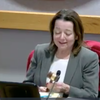Indigenous ways of knowing are a totem for Sarah Walsh
When Sarah Walsh was working with indigenous people in Canada, she experienced a national Thanksgiving address.
“It is a way of acknowledging every piece of the Earth … and to center yourself in your role as a human being in the Earth, not on the Earth, but in the Earth, and how it influences who you are and how life happens,” she says in this week’s Enterprise podcast.
Walsh is now the associate director of the Mohawk Hudson Land Conservancy where she oversees an initiative to honor the indigenous history of the Bozen Kill Conservation Corridor. On Friday, a ceremony was held to celebrate new kiosk signs at the Bozen Kill and Wolf Creek Falls Preserves to inform visitors of the land’s history.
“Mohawk Hudson Land Conservancy’s intention is to preserve and act as stewards of the traditional lands of the Mohican people, now known as the Stockbridge-Munsee Community located in Wisconsin, and the traditional lands of the Mohawk people,” says the conservancy’s acknowledgement. “The nature of the Tenonanatche (Mohawk River) meaning a river flowing through a mountain and the Mahicannituck (Hudson River), meaning the river that flows both ways, and the resources they provide were important then, are important now and will always be important.”
Walsh lives with her husband, 12 chickens, and two dogs, in an old farmhouse on four acres near the Wolf Creek Falls Preserve. She’s proud of the work the conservancy has done over the last two decades to preserve the 400 acres of the Bozen Kill corridor — the stream is a tributary to the Watervliet Reservoir. In addition to the two public preserves, acreage between is protected for wildlife.
Walsh grew up on a 96-acre farm on a dirt road in the most northern reaches of New York State near the Canadian border. Her parents had left Connecticut and “the hustle and bustle of city life” for the North Country.
At age 12, Walsh drove her own team of draft horses to do the haying. The family raised pigs and chickens and her mother kept a huge garden, canning produce in summer to last through winter months.
“I always had a great connection to the land because that was my entertainment,” said Walsh, noting she was born in 1984 before cell phones and her family had no cable access on television.
Walsh originally thought she’d be a music teacher like her mother but her mother saw the environment was really Walsh’s deeper passion. Her mother took her to visit the Environmental School of Science and Forestry at Syracuse “and it just clicked,” said Walsh.
Her first year at university, Walsh had Robin Wall Kimmerer as a botany professor; Kimmerer, a member of the Citizen Potawatomi Nation, has written several popular books on the ethnobotanical world.
For bonus points in Kimmerer’s class, Walsh did a presentation on a plant, showing from the scientific side, “the identification characteristics, but more interestingly, you had to go back and figure out how the plant was used medicinally,” she said.
“This was really my first foray into indigenous knowledge and ways of knowing, and that has been a totem for me throughout my career,” said Walsh.
In her six years at the Mohawk Hudson Land Conservancy — the first five as conservation director, overseeing land stewardship and property acquisitions — inclusivity has been central for Walsh.
She started a program where CDTA buses, for free, bring city residents to country properties, including conservancy lands.
“My husband would say, ‘Sarah, you became woke during the pandemic,’ …,” said Walsh. “Coming from a very white, very remote location, I didn’t have a lot of access to diversity and I had a lot of privilege, which I didn’t realize until later in life, in my adulthood.”
This idea of her privilege developed as she and her husband purchased their first home along with the Black Lives Matter movement and the pandemic, she said. “To be able to walk out my back door and be in open space and recreate, and not everyone has that …,” she said. “And that’s how the idea of the Nature Bus came to be.”
The Capital District Transportation Authority was a willing partner as were Thacher Park and Five Rivers to get city residents to “interact with nature … to be able to breathe a sigh of relief; it was the only safe place for people to gather during the pandemic.”
The Nature Bus ran for 15 Saturdays in 2021 and for 18 Saturdays this year with added programming including guided hikes “so that people get hooked on nature,” said Walsh.
Before Walsh came to the Mohawk Hudson Land Conservancy, she worked in the Thousand Islands region, involved with The Algonquin to Adirondacks Collaborative, an environmental not-for-profit that connects lands and people from Algonquin Provincial Park in Ontario to the Adirondacks in New York.
“They made sure that the indigenous communities were front and center and a part of every conversation,” said Walsh. “So I learned a lot from the Canadians and how they are working really hard to right the wrongs of the past.”
The Mohawk Hudson Land Conservancy, in its 30th year, has kicked off strategic planning to connect the Catskills with the Adirondacks, Walsh said, to ensure there are pathways for wildlife to move and also to protect clean air and water.
“A huge part of that is acknowledging the people, the original stewards that came here first. So, on the heels of the Black Lives Matter movement, we were sort of feeling like we had this opportunity to really right some wrongs …
“The land we’re protecting was actually stolen land that was, you know, taken from the original people that lived here on the land before European contact. And so we went down this pathway, as a team, of figuring out: How do we honor those that came before us and were the original stewards of this land?”
A good starting point for anyone who would like to trace the history of the lands on which they live, said Walsh, is the Native Lands Interactive Map: https://native-land.ca/. She also cited a website from the United States Department of Arts and Culture on how to honor native land: https://usdac.us/nativeland.
A useful book, she said, is “A History of Native American Land Rights in Upstate New York” by Cindy Amrhein, which, Walsh said, “sets up this evidence of how the land was taken away, oftentimes without people really knowing.”
“The first thing,” Walsh said in researching land history, “is not assuming that you know whose land you’re on.”
The native-land website “shows the approximate boundaries of the indigenous folks across the United States, Canada, and other areas in the world,” she said, “so that you can find out who has existed and exists where you’re living now or where you are working now.”
Walsh stressed, “The most important part of this whole process is to reach out to the nations that you’re trying to honor. So, I’m just a white girl who really doesn’t know too much,” she said of the place where she started.
Once Walsh discovered the Bozen Kill properties were on the traditional unceded lands of the Stockbridge-Munsee Mohican community, she reached out directly to the community.
She urged engaging not in a “transactional conversation, but one that will grow and continue and evolve into a relationship long-term.”
Walsh said of the Stockbridge Munsee Community, “They started out here in the Hudson Valley and were pushed out to Stockbridge, Massachusetts, and then moved to Wisconsin … The community is, you know, physically here, but not all the Mohicans left. And there are still Mohicans that exist on the land today ….
“We are also in Mohawk territory as well.” So Walsh worked with people from both the Mohican and Mohawk communities.
She worked with Heather Bruegel of the Stockbridge-Munsee Community whom she described as “a life force.” Walsh said Bruegel has a passion, particularly for her people’s history, that was infectious.
“Her connection as a historian, also as an indigenous person sort of tells the history in a very different light than the schools in the United States teach it,” said Walsh, describing some of that history: Mohicans were “pushed off of the land and put on these tiny little pieces of reserved land in some of the harshest conditions and marginalized in such a way that many of them didn’t survive.”
Walsh went on, “Heather is just amazing at not only telling the history but not doing it in a way that is shaming but in a way that is just true fact and helps you wrap your head around the history and how to make it different moving forward.”
Walsh also worked with Kay Allen, a Mohawk storyteller and retired school teacher. “She is the knowledge keeper and storyteller … and we spent I don’t know how much time on the phone going over every word of the acknowledgment together and being so incredibly thoughtful about what we were saying, why we were saying it, and making sure we were saying it properly to pay the proper homage.”
Walsh went on, “I think the European culture is go, go, go go, go. And I’ve learned so much from her to sort of … take a breath, more like five breaths, and really think about things in a really thoughtful, slow manner.”
Finally, Walsh worked with David Arquette of the Haudenosaunee Environmental Task Force, whom she knew from her first job as a fisheries technician on the Saint Lawrence. “The Environmental Task Force is scientific as well as indigenous and is working through some of these really tough, horrible environmental legacies that we have left behind on lands that were not ours to begin with.
“So David Arquette was very kind to take a look at and bring our indigenous land acknowledgement to the elders there to ensure that it was in keeping with what we should be saying.”
Walsh concluded by urging other organizations and individuals to research the history of the lands they live and work on.
“You can create a sign for your property that talks about your own indigenous land acknowledgment …,” said Walsh. “I also encourage people to engage with our native communities to learn more.”
One of the books Walsh named, coming full circle, is by her professor, Kimmerer, who had taught her about ethnobotany as an undergraduate.
Kimmerer’s book, “Braiding Sweetgrass: Indigenous Wisdom, Scientific Knowledge, and the Teachings of Plants,” centers on the reciprocal relationship human beings need to have with the rest of the living world.
“We are showered every day with gifts, but they are not meant for us to keep,” Kimmerer writes in “Braiding Sweetgrass.” “Their life is that in their movement, the inhale and exhale of our shared breath. Our work and our joy is to pass along the gift and to trust that what we put out into the universe will always come back.”
The sentiment is similar to that expressed in Mohawk Hudson Land Conservancy’s acknowledgement: “MHLC’s commitment to preserving these natural resources honors the legacy of the Mohican and Mohawk peoples as the stewards who nurtured this land since time immemorial. We honor and respect their historic and continuing dedication to taking care of the natural world and commit our efforts to making these lands a more inclusive and equitable environment for all.”



